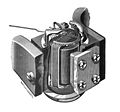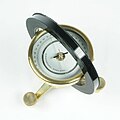Galvanometer
Galvanometer is a scientific instrument used for detecting and measuring electric current. It was named after the Italian scientist Luigi Galvani, who conducted extensive research on bioelectricity. The galvanometer works by the principle of electromagnetic deflection, where a magnetic needle or coil is deflected under the influence of electric current flowing through a coil.
History[edit]
The Galvanometer was first described by Johann Schweigger at the University of Halle on 16 September 1820. This early version of the galvanometer was a crude instrument with a coil of wire wrapped around a compass. It was later improved upon by André-Marie Ampère, who added a fixed magnet to the device.
Types of Galvanometers[edit]
There are several types of galvanometers, including the Tangent galvanometer, the Astatic galvanometer, and the Ballistic galvanometer. Each of these types has its own unique characteristics and uses.
Tangent Galvanometer[edit]
The tangent galvanometer is a type of galvanometer that uses the tangent law of magnetism to measure electric current. It consists of a coil of insulated copper wire wound on a circular non-magnetic frame.
Astatic Galvanometer[edit]
The astatic galvanometer is a type of galvanometer that is designed to minimize the effect of the earth's magnetic field on the instrument's operation. It does this by using two magnetic needles, one above the other, with their magnetic fields opposing each other.
Ballistic Galvanometer[edit]
The ballistic galvanometer is a type of galvanometer that is designed to measure the quantity of electricity discharged through it. It is used in experiments where the total quantity of electricity needs to be measured rather than the current.
Applications[edit]
Galvanometers have a wide range of applications in various fields. They are used in physics laboratories for experiments, in industries for detecting and measuring electric current, and in medical equipment like electrocardiograms and electroencephalograms to measure the electrical activity of the heart and brain respectively.
See Also[edit]
References[edit]
<references />
Ad. Transform your life with W8MD's Budget GLP-1 injections from $75


W8MD offers a medical weight loss program to lose weight in Philadelphia. Our physician-supervised medical weight loss provides:
- Weight loss injections in NYC (generic and brand names):
- Zepbound / Mounjaro, Wegovy / Ozempic, Saxenda
- Most insurances accepted or discounted self-pay rates. We will obtain insurance prior authorizations if needed.
- Generic GLP1 weight loss injections from $75 for the starting dose.
- Also offer prescription weight loss medications including Phentermine, Qsymia, Diethylpropion, Contrave etc.
NYC weight loss doctor appointmentsNYC weight loss doctor appointments
Start your NYC weight loss journey today at our NYC medical weight loss and Philadelphia medical weight loss clinics.
- Call 718-946-5500 to lose weight in NYC or for medical weight loss in Philadelphia 215-676-2334.
- Tags:NYC medical weight loss, Philadelphia lose weight Zepbound NYC, Budget GLP1 weight loss injections, Wegovy Philadelphia, Wegovy NYC, Philadelphia medical weight loss, Brookly weight loss and Wegovy NYC
|
WikiMD's Wellness Encyclopedia |
| Let Food Be Thy Medicine Medicine Thy Food - Hippocrates |
Medical Disclaimer: WikiMD is not a substitute for professional medical advice. The information on WikiMD is provided as an information resource only, may be incorrect, outdated or misleading, and is not to be used or relied on for any diagnostic or treatment purposes. Please consult your health care provider before making any healthcare decisions or for guidance about a specific medical condition. WikiMD expressly disclaims responsibility, and shall have no liability, for any damages, loss, injury, or liability whatsoever suffered as a result of your reliance on the information contained in this site. By visiting this site you agree to the foregoing terms and conditions, which may from time to time be changed or supplemented by WikiMD. If you do not agree to the foregoing terms and conditions, you should not enter or use this site. See full disclaimer.
Credits:Most images are courtesy of Wikimedia commons, and templates, categories Wikipedia, licensed under CC BY SA or similar.
Translate this page: - East Asian
中文,
日本,
한국어,
South Asian
हिन्दी,
தமிழ்,
తెలుగు,
Urdu,
ಕನ್ನಡ,
Southeast Asian
Indonesian,
Vietnamese,
Thai,
မြန်မာဘာသာ,
বাংলা
European
español,
Deutsch,
français,
Greek,
português do Brasil,
polski,
română,
русский,
Nederlands,
norsk,
svenska,
suomi,
Italian
Middle Eastern & African
عربى,
Turkish,
Persian,
Hebrew,
Afrikaans,
isiZulu,
Kiswahili,
Other
Bulgarian,
Hungarian,
Czech,
Swedish,
മലയാളം,
मराठी,
ਪੰਜਾਬੀ,
ગુજરાતી,
Portuguese,
Ukrainian













